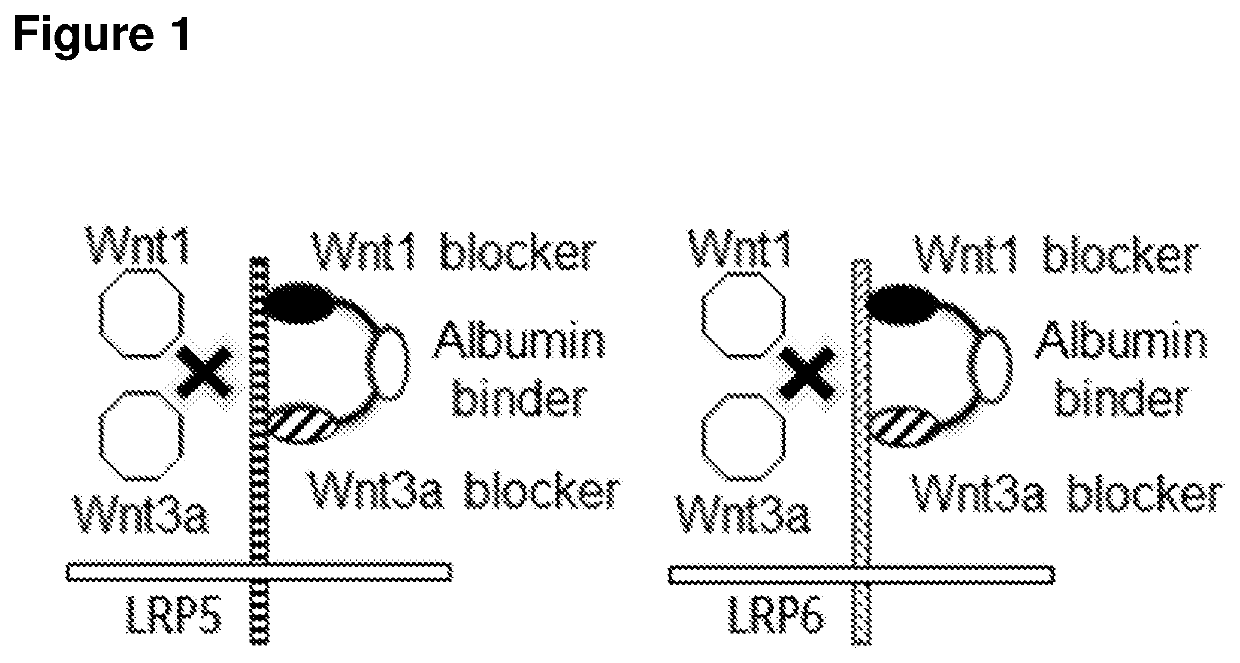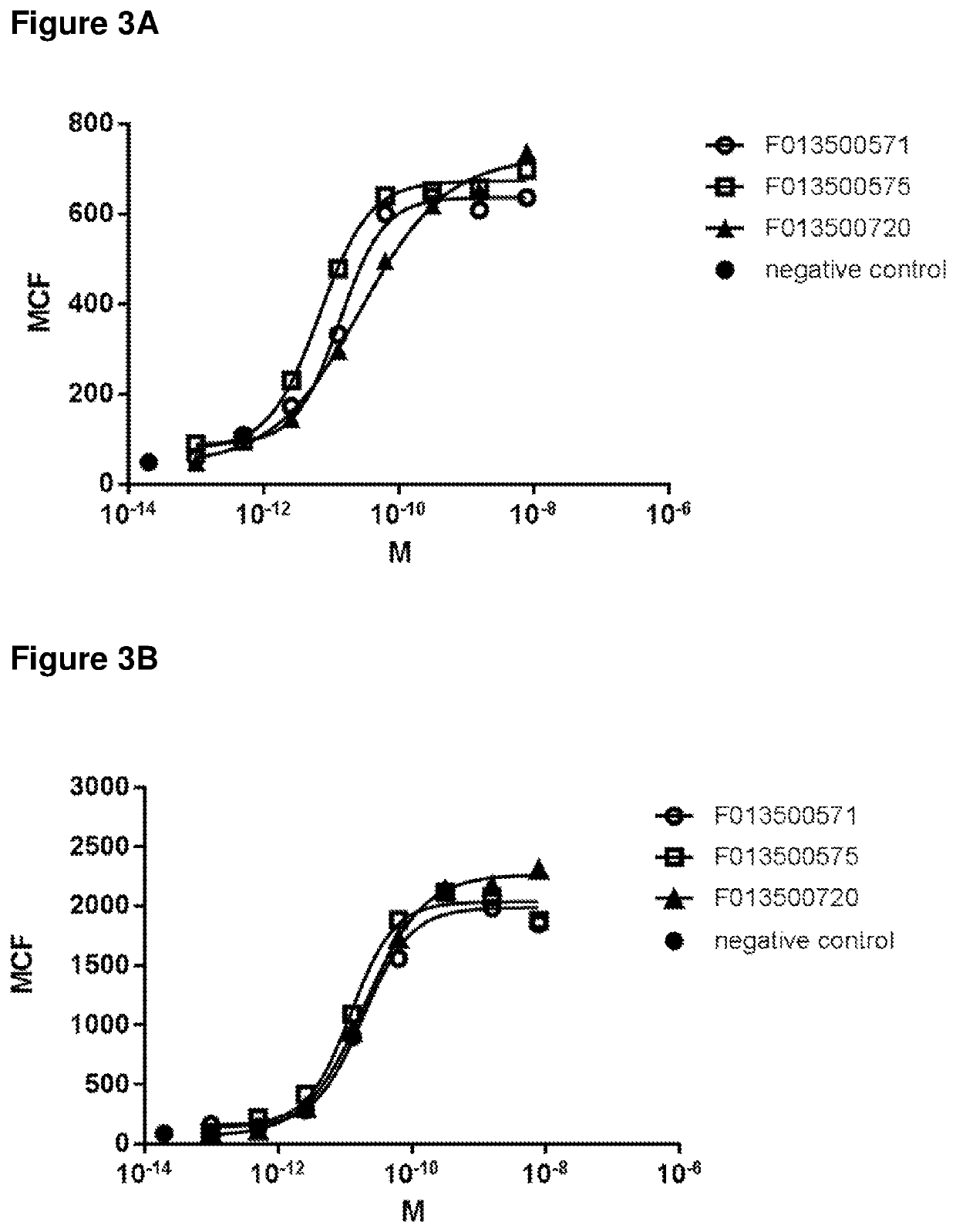Biparatopic polypeptides antagonizing Wnt signaling in tumor cells
a polypeptide and tumor cell technology, applied in the field of biparatopic polypeptides antagonizing wnt signaling in tumor cells, can solve the problems of inability to define the exact epitopes involved in wnt1 or wnt3a ligand binding, inability to elucidate the epitopes within the beta-propeller 1, 2 and 3 domains involved in dkk1 binding to lrp6, and inability to cause sever
- Summary
- Abstract
- Description
- Claims
- Application Information
AI Technical Summary
Benefits of technology
Problems solved by technology
Method used
Image
Examples
first preferred embodiment
[0109]Polypeptides comprising a first immunoglobulin single variable domain having the following CDR sequences:
[0110]
CDR1:(=SEQ ID NO: 1)TYTVGCDR2:(=SEQ ID NO: 2)AIRRRGSSTYYADSVKGCDR3:(=SEQ ID NO: 3)DTRTVALLQYRYDY
and a second immunoglobulin single variable domain having the following CDR sequences:
[0111]
CDR1:(=SEQ ID NO: 10)SYAMGCDR2:(=SEQ ID NO: 11)AISWSGGSTYYADSVKGCDR3:(=SEQ ID NO: 12)SPIPYGSLLRRRNNYDY.
second preferred embodiment
[0112]Polypeptides comprising a first immunoglobulin single variable domain having the following CDR sequences:
[0113]
CDR1:(=SEQ ID NO: 4)SYAMGCDR2:(=SEQ ID NO: 5)AIRRSGRRTYYADSVKGCDR3:(=SEQ ID NO: 6)ARRVRSSTRYNTGTWWWEY
and a second immunoglobulin single variable domain having the following CDR sequences:
[0114]
CDR1:(=SEQ ID NO: 13)SYAMGCDR2:(=SEQ ID NO: 14)AISWRSGSTYYADSVKGCDR3:(=SEQ ID NO: 15)DPRGYGVAYVSAYYEY.
third preferred embodiment
[0115]Polypeptides comprising a first immunoglobulin single variable domain having the following CDR sequences:
[0116]
CDR1:(=SEQ ID NO: 7)RYTMGCDR2:(=SEQ ID NO: 8)AIVRSGGSTYYADSVKGCDR3:(=SEQ ID NO: 9)DRRGRGENYILLYSSGRYEY
and a second immunoglobulin single variable domain having the following CDR sequences:
[0117]
CDR1:(= SEQ ID NO: 13)SYAMGCDR2:(= SEQ ID NO: 14)AISWRSGSTYYADSVKGCDR3:(= SEQ ID NO: 15)DPRGYGVAYVSAYYEY.
[0118]Of course, the variants as set out above—i.e. optionally including linker peptides and / or further domains, esp. including an Alb11 domain, different orders of the immunoglobulin single variable domains—shall apply to these three preferred embodiments as well.
[0119]In a specifically preferred embodiment, the albumin binding immunoglobulin single variable domain is located between the two LRP5 / LRP6 binding immunoglobulin single variable domains. Thus, three specifically preferred embodiments can be envisaged as follows:
[0120]First specifically preferred embodiment: Polyp...
PUM
| Property | Measurement | Unit |
|---|---|---|
| Tm | aaaaa | aaaaa |
| dissociation constant | aaaaa | aaaaa |
| dissociation constant | aaaaa | aaaaa |
Abstract
Description
Claims
Application Information
 Login to View More
Login to View More - R&D
- Intellectual Property
- Life Sciences
- Materials
- Tech Scout
- Unparalleled Data Quality
- Higher Quality Content
- 60% Fewer Hallucinations
Browse by: Latest US Patents, China's latest patents, Technical Efficacy Thesaurus, Application Domain, Technology Topic, Popular Technical Reports.
© 2025 PatSnap. All rights reserved.Legal|Privacy policy|Modern Slavery Act Transparency Statement|Sitemap|About US| Contact US: help@patsnap.com



